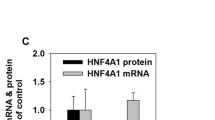Abstract
Purine nucleoside phosphorylase (PNP) levels are modulated during the growth cycle of rat hepatoma cells and increase two- to three-fold as cells go from early exponential growth phase to stationary growth phase. A mutant of these hepatoma cells has been isolated which is deficient in PNP activity. Quantitative immunoprecipitation tests indicate that the decrease in enzyme activity is due to a decrease in the number of PNP molecules. The low level of PNP enzyme produced by the mutant, however, is indistinguishable from the wild-type enzyme, suggesting that the mutant may be defective in the ability to modulate PNP levels. Fusion of the mutant cells to wild-type parental cells results in hybrids that express the mutant phenotype. Segregants that arise from the hybrids show chromosome loss and reexpression of the wild-type parental phenotype, the mutant parental phenotype, and a 2S wild-type phenotype. These indicate the following about the defect in modulation in the mutant PNP-100: (1) it is trans dominant to the wild-type; (2) its effect is negative; (3) some genomic element is required for its continued effect; and (4) it does not act by obliterating its functioning counterpart in hybrid cells.
Similar content being viewed by others
Literature cited
Giblett, E.R., Ammann, A.J., Wara, D.W., Sandman, R., and Diamond, L.K. (1975).Lancet 1:1010–1013.
Carson, D.A., Kaye, J., and Seegmiller, J.E. (1977).Proc. Natl. Acad. Sci. U.S.A. 74:5677–5681.
Chan, T. (1978).Cell 14:523–530.
Cohen, A.,, Gudas, L.J., Ammann, A.J., Staal, G.E.J., and Martin, D.W., Jr. (1978).J. Clin. Invest. 61:1405–1409.
Edwards, N.L., Gelfand, E., Biggar, D., and Fox, I.H. (1978).J. Lab. Clin. Med. 91:736–749.
Gelfand, E.W., Dosch, H.M., Biggar, W.D., and Fox, I.H. (1978).J. Clin. Invest. 61:1071–1080.
Carson, D.A., Kaye, J., Matsumoto, S., Seegmiller, J.E., and Thompson, L. (1979).Proc. Natl. Acad. Sci. U.S.A. 76:2430–2433.
Gudas, L., Ullman, B., Cohen, A., and Martin, D.W., Jr. (1978).Cell 14:531–538.
Mitchell, B.S., Mejias, E., Daddona, P.E., and Kelley, W.N. (1978).Proc. Natl. Acad. Sci. U.S.A. 75:5011–5014.
Ullman, B., Cohen, A., and Martin, D.W., Jr. (1976).Cell 9:205–211.
Ullman, B., Gudas, L., Clift, S., and Martin, D.W., Jr. (1979).Proc. Natl. Acad. Sci. U.S.A. 76:1074–1078.
Hoffee, P. (1979).Somat. Cell Genet. 5:319–328.
May, R., and Hoffee, P. (1978).Arch. Biochem. Biophys. 190:712–719.
Bremner, T.A., Premkumar-Reddy, E., Nayar, K., and Kouri, R.E. (1978).Biochem. Genet. 16:1143–1151.
Synder, F.A., Biddle, F.G., Lukey, T., and Sparling, M.J. (1982).J. Clin. Chem. Clin. Biochem. 20:420.
Lincoln, D.W., and Hoffee, P. (1979).Arch. Biochem. Biophys. 193:392–397.
Jargiello, P. (1978).Somat. Cell Genet. 4:647–660.
Hayflick, J. (1965).Texas Rep. Biol. Med. 23:285–303.
Chen, T.R. (1977).Exp. Cell Res. 104:255–262.
Gefter, M., Margulies, D.H., and Scharff, M.D. (1977).Somat. Cell Genet. 3:231–236.
Silnutzer, J., and Jargiello, P. (1981).Somat. Cell Genet. 7:119–131.
Velazques, A., Payne, F.E., and Krooth, R.S. (1971).J. Cell. Physiol. 78:93–110.
Machall, J., Meredith, M., and Lane, M.D. (1979).Anal. Biochem. 95:270–274.
Kalckar, H. (1947).J. Biol. Chem. 167:461–575.
Bradford, M. (1976).Anal. Biochem. 72:248–254.
May, R., and Hoffee, P. (1979).Arch. Biochem. Biophys. 193:398–406.
Edwards, Y.H., Hopkinson, D.A., and Harris, H. (1971).Ann. Hum. Genet. 34:395–423.
Uziel, M., and Selkirk, J. (1979).J. Supramol. Struct. 11:197–205.
Uziel, M., and Selkirk, J. (1979)J. Cell Physiol. 99:217–222.
Author information
Authors and Affiliations
Rights and permissions
About this article
Cite this article
Hoffee, P.A., Hunt, S.W., Chiang, J. et al. Evidence for a trans-dominant regulator of purine nucleoside phosphorylase expression in rat hepatoma cells. Somat Cell Mol Genet 9, 249–267 (1983). https://doi.org/10.1007/BF01543180
Received:
Revised:
Issue Date:
DOI: https://doi.org/10.1007/BF01543180




